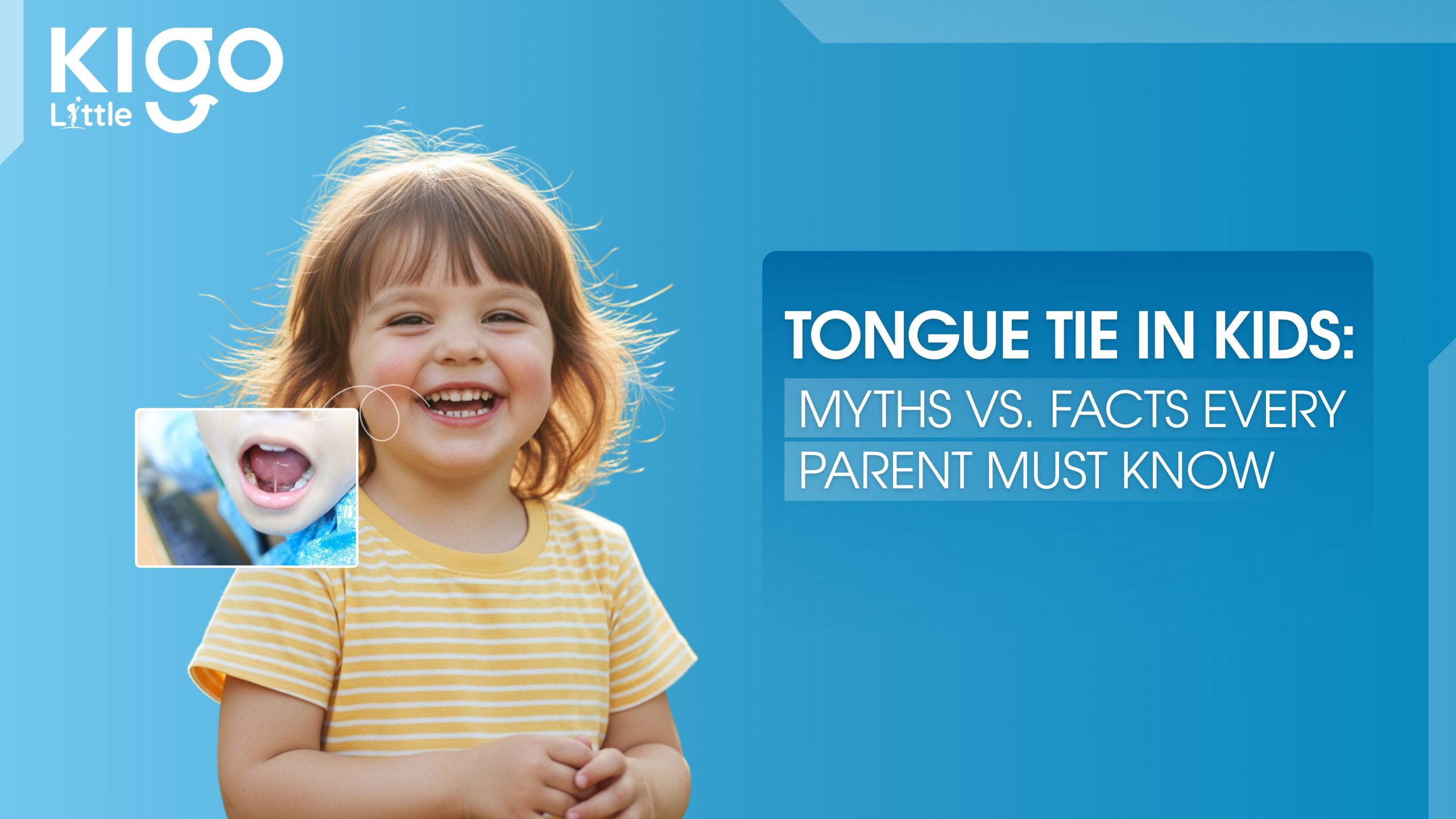You’re Not Alone
Watching your child struggle—whether it’s during feeding, speech, or sleep—can be a heart-wrenching experience. Many parents silently worry: Is this normal? Will it ever get better? Whether it’s the pain of repeated nursing, your toddler’s mumbled speech, or relentless bedtime battles, such struggles can weigh heavily on both parents and kids.

At Kigo Little, we’re not just here to treat—you’re heard. You’re seen. You’re supported. Here’s what every parent should know about Tongue Tie in Kids, clear the myths, embrace the facts, and find hope and healing.
Myth vs. Fact: Understanding the Truth About Tongue Tie
Myth | Fact |
A tongue tie is just a minor issue. | It’s a real condition that can meaningfully impact feeding, speech, oral development, and sleep. |
All tongue ties need surgery. | Not every tongue tie requires treatment unless symptoms arise. |
Treatment is painful and complicated. | Modern methods are quick, safe, and gentle—with minimal discomfort and fast healing. |
Myth 1 – It’s Just a Tiny Tissue, No Big Deal
Fact: A tongue tie or ankyloglossia—refers to a tight or short band of tissue under the tongue that limits its movement. This small restriction can trigger big consequences—like difficulty with latching, delayed speech, and even sleep breathing issues impacting overall wellness. That’s why recognizing Tongue-tie symptoms early matters.
Myth 2 – If They’re Feeding Fine, Leave It Alone
Fact: Some children compensate well and seem “fine,” but struggles can hide beneath the surface. Moms may endure nipple pain or low milk supply, and older children may grow frustrated with food, delay speech, or sleep poorly. Ignoring it can mean missing a key opportunity to improve quality of life.
Myth 3 – Treatment Is Scary
Fact: At Kigo Little, tongue tie treatment is a targeted, gentle process—typically a precise release (frenectomy) that takes just minutes. Many clients return to everyday life almost immediately, with just a few simple exercises at home to enhance healing.
How Kigo Little Helps: A Compassion-Driven Journey
- Consultation and Assessment
Every visit starts with listening: What did you observe? What’s troubling feeding, speech, or sleep? Our experienced pediatric dentists evaluate mobility of the tongue and look for signs of tethering or restriction. This careful approach ensures treatment is evidence-based and individualized.
- Shared Real-World Stories
case #1: A two-week-old baby, whom we’ll call “Arya,” came in with a shallow latch and long nursing sessions. Her mom was in tears from sore nipples and worry about milk supply. After a gentle frenectomy at Kigo Little, Arya nursed more effectively, and feeding sessions shortened. Mom’s pain eased, and both regained their joy.
case #2: Four-year-old “Vihaan” spoke quietly and avoided words with “r,” “th,” and “l.” He seemed self-conscious. We performed a targeted release, followed by simple tongue exercises. Within a few weeks, his speech clarity improved, and his confidence soared. His mom told us, “It was a subtle shift—but it changed everything.”
- The Frenectomy Procedure (Tongue Tie Treatment)
The procedure is quick (often just a few minutes) and extremely precise, often using laser or advanced surgical tools. Discomfort is minimal. Post-procedure, parents are taught gentle stretching exercises to support healing and prevent reattachment—simple routines done at home, three times a day for a few weeks.
- Benefits & Expected Outcomes
Feeding & Latch: Infants nurse more efficiently, with less pain and frustration.
Speech Clarity: Older children articulate better, often immediately noticing improved sound production.
Comfort & Confidence: Eating transitions from stressful to joyful, with less gagging or texture avoidance.
Sleep & Behavior: With improved tongue function, some kids breathe more easily and even see better sleep quality.
Frequently Asked Questions
Q: What are common tongue-tie symptoms?
A: Symptoms include difficulty latching, clicking or smacking noises, feeding fatigue, speech delays (especially with L, R, TH, S sounds), limited tongue movement, sleep disruptions, or chronic gagging—all worth evaluating.
Q: When is tongue-tie treatment necessary?
A: Treatment is recommended when functional issues arise. If your child is feeding well, sleeping soundly, and speaking clearly, monitoring may suffice. Functional impairment guides the decision.
Q: Is the procedure painful?
A: No—it’s typically quick, with numbing or laser precision. Discomfort is minimal to none, and kids often bounce right back to normal.
Q: What aftercare is required?
A: Simple tongue/tissue stretches at home, a few times daily for a few weeks. These help healing and reduce the chance of reattachment.
Q: Are there risks?
A: Risks are very low. The technique is precise, recovery is rapid, and the tissue heals well. Our team guides you every step.
Final Thoughts: Empowered Parenting Through Knowledge
Knowing the facts about Tongue Tie in Kids empowers you to make confident, informed decisions. Whether it’s feeding struggles, speech hurdles, or simply that gut feeling—waiting isn’t always your best friend. Kigo Little’s caring, expert team is here to help navigate the path from uncertainty to comfort, clarity, and confidence.
Let’s Unlock Your Child’s Potential
Don’t let myths hold your child back. If subtle frustrations turn into everyday challenges, or if something simply feels off—reach out to Kigo Little for a consultation.
Visit: https://kigolittle.com/
Contact: +91 8333999987





